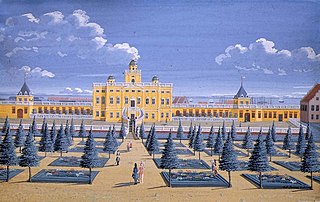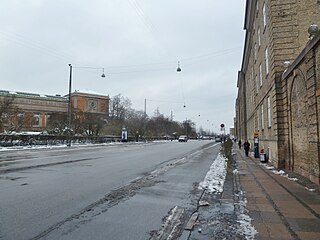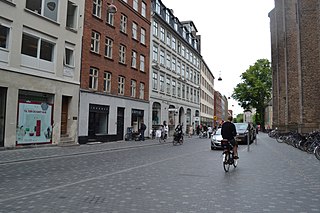
Ulrik Frederik Gyldenløve, Landgrave of Laurvig was Governor-general of Norway from 1664–1699. He was the leading general in Norway during the Scanian War, whose Norwegian leg is conventionally named the Gyldenløve War after him. In Norway he was also the Landgrave of Laurvig.

Charlotte Amalie of Hesse-Kassel was Queen of Denmark and Norway by marriage to King Christian V. Although she did not have much political influence, she was a successful businesswoman in her many estates and protected foreign Protestant non-Lutherans from oppression. She gained popularity for defending Copenhagen from Swedish forces in 1700.

The Copenhagen Fire of 1728 was the largest fire in the history of Copenhagen, Denmark. It began on the evening of 20 October 1728 and continued to burn until the morning of the 23rd of October 1728. It destroyed approximately 28% of the city and left 20% of the population homeless. The reconstruction lasted until 1737. No less than 47% of the section of the city, which dates back to the Middle Ages, was completely lost, and along with the Copenhagen Fire of 1795, it is the main reason that few traces of medieval Copenhagen can be found in the modern city.

The Church of Our Lady is the Lutheran cathedral of Copenhagen. It is situated on the Frue Plads public square in central Copenhagen, next to the historic main building of the University of Copenhagen.

St. Peter's Church is the parish church of the German-speaking community in Copenhagen, Denmark. It is situated at the corner of Nørregade and Sankt Peders Stræde in the city's Latin Quarter. Built as a single-nave church in the mid-15th century, it is the oldest building in central Copenhagen. It is also notable for its extensive complex of sepulchral chapels.

Rosenborg Castle Gardens is the oldest and most visited park in central Copenhagen, Denmark. Established in the early 17th century as the private gardens of King Christian IV's Rosenborg Castle, the park also contains several other historical buildings, including Rosenborg Barracks, home to the Royal Guards, as well as a high number of statues and monuments. The park also holds art exhibitions and other events such as concerts in the summer.

The Holmen Church is a Parish church in central Copenhagen in Denmark, on the street called Holmens Kanal. First built as an anchor forge in 1563, it was converted into a naval church by Christian IV. It is famous for having hosted the wedding between Margrethe II of Denmark, queen of Denmark between 1972 and 2024, and Prince Henrik in 1967. It is the burial site of such notabilities as naval heroes Niels Juel and Peter Tordenskjold, and composer Niels Wilhelm Gade, and contains artwork by, among others, Bertel Thorvaldsen and Karel van Mander.

Christian's Church is a Rococo church in the Christianshavn district of Copenhagen, Denmark. Designed by Nicolai Eigtved, it was built 1754–59.

Sophie Amalienborg was a pleasure palace roughly located where Amalienborg stands today in Copenhagen, Denmark. It was built by Queen Consort Sophie Amalie who lived there until her death in 1685 after her husband, King Frederick III, died a few years prior to its completion.

Gothersgade is a major street in the City Centre of Copenhagen, Denmark. It extends from Kongens Nytorv to Sortedam Lake, passing Rosenborg Castle and Gardens, Nørreport Station and Copenhagen Botanic Gardens on the way.

St. Andrew's Church is a Lutheran church on Gothersgade in Copenhagen, Denmark, which was designed by the architect Martin Borch and built from 1897 to 1901. It is a parish church within the Danish National Church.

St. Paul's Church is a Lutheran church in central Copenhagen, Denmark, also colloquially known as Nyboder's Church due to its location in the middle of the Nyboder area. It was designed by Johannes Emil Gnudtzmann and constructed from 1872 to 1877.

Øster Voldgade, together with Vester Voldgade and Nørre Voldgade, forms a succession of large streets which arches around the central and oldest part of the Zealand side of Copenhagen, Denmark. It runs north-east from Gothersgade at Nørreport Station to Georg Brandes Plads, between the Copenhagen Botanical Gardens and Rosenborg Castle Gardens, and continues straight to a large junction at the southern end of Oslo Plads, near Østerport Station, where it turns into Folke Bernadotte Allé.

Frederiksberg Church is the oldest church building in the Frederiksberg district of Copenhagen, Denmark. Completed in 1734, it is built to an unusual octagonal design in Baroque style. It is situated at Frederiksberg Runddel in front of the main entrance to Frederiksberg Gardens, on the corner of Frederiksberg Allé and Pile Allé,

Gammel Mønt is a street in central Copenhagen, Denmark, located one block west of Gothersgade and Rosenborg Castle Garden.

Landemærket, literally "The Landmark", is a street in the Old Town of Copenhagen, Denmark. It extends from Købmagergade along the north side of the Trinitatis Complex (Round Tower and Trinitatis Church, Guttenberghus and the Film House to Gothersgade at Rosenborg Castle Gardens.

Adelgade is a street in central Copenhagen, Denmark. It runs from Gothersgade in the south to Sankt Pauls Plads with St. Paul's Church in the north. The first half of the street is dominated by modern buildings while its last section passes through the Nyboder district.

Åbenrå is a street in the Old Town of Copenhagen, Denmark. It runs from Landemærket in the southeast to Rosenborggade in the northwest, linking Vognmagergade with Tornebuskgade. The last part of the street passes the rear side of the grounds of the Reformed Church in Gothersgade. The former rectory associated with the church is located at No. 32-36. It is now houses the Danish Association of Architects.

Gysbert Wigand Michelbecker was a Danish merchant, shipowner and property owner. He was one of the largest merchants in Copenhagen of his day and was from 1687 the owner of a large property at Frederiksholms Kanal in Copenhagen where the National Museum of Denmark stands today.

Rosenborggade 19 is an 18th-century property situated at the corner of Rosenborggade and Gothersgade, opposite Rosenborg Castle and next to the Reformed Church, in the Old Town of Copenhagen, Denmark. It was expanded with a detached two-storey building at Gothersgade 113 in 1825. The two buildings were both listed in the Danish registry of protected buildings and places in 1987.
























